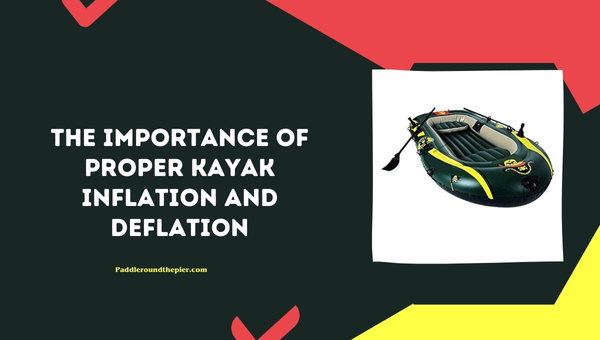Kayak Inflation and Deflation: Your Ultimate Guide
So, you're finally taking that long-awaited kayaking trip this weekend. That's fantastic! I bet you can't wait to tackle the thrills and spills of the open water. Don't forget that your journey always starts on land with the critical processes of kayak inflation and deflation. There are certainly some crucial points to pinpoint in handling your inflatable kayak safety and performance.
In this ultimate guide to "Kayak Inflation and Deflation," we'll walk through not only how to inflate or deflate a kayak effectively but also why it's important for safety measures and optimal performance. We'll provide step-by-step instructions with some essential maintenance tips thrown in for good measure.
Here's What You Can Expect To Learn:
- Why proper Kayak inflation or deflation is a no-skip procedure.
- How To Inflate a Kayak.
- The must-know steps for Kayak Deflation without damaging it.
- Handy tips & tricks for efficient Kayak Maintenance, including inspection routines, repairs, troubleshooting, etc.
- The Importance of regular inspections in maintaining your beloved kayak.
The Importance of Proper Kayak Inflation and Deflation
There's more to kayaking than just paddling and admiring the beauty of serene waters; ensuring the proper Kayak Inflation and Deflation is certainly a key aspect of safe and enjoyable paddling. Let's take a closer look at why this matters.

Safety implications
One thing I learned in my numerous kayaking adventures is that safety always comes first. I found that the most integral safety factor involves correctly inflating and deflating my kayak.
An over-inflated kayak risks bursting, especially in warm weather when the air inside expands. Besides, it can become very rigid, making it susceptible to punctures and rapid deflation, which puts you at risk if you're out in deep water.
On the other hand, an under-inflated kayak can have its drawbacks too. It may not support your weight correctly or handle buoyancy as it should. This could lead to capsizing or make taking much harder than it needs to be.
In either case, if your vessel isn't properly inflated or deflated when disaster strikes - whether you're in choppy rivers or calm lake waters - such miscalculations can put a real damper on your outdoor adventure.
Optimal Performance
Apart from safety concerns surrounding Kayak Inflation and Deflation, there's also performance! Like many who take to bodies of water on these slim vessels for relaxation or sporty fun, I've noticed a significant difference in performance based on how well my inflatable kayak is handled before launch time.
An adequately inflated kayak behaves more responsively to paddle strokes; it glides smoothly through water without unnecessary drags caused by sagging parts. The right amount of firmness evenly distributes your weight across its surface – giving better stability on waters with waves coming in unpredictable directions.
Managing proper deflation after use is equally critical because improper storage can lead to damage, such as creases that undermine the structural stability of your kayak and compromise future performance.
Keeping an eye on the proper inflation and deflation of my kayak has made a real difference in how much I enjoy my time out on the water, which convinces me even more about its importance!
Remember, it's all about finding that 'just right' level of firmness – not too soft, not too hard! It definitely takes practice and patience but guarantees ultimate paddling performance every time.
Also Read: Verde River Kayaking Destination: Why Is It Unique?
Basics of Kayak Inflation
Inflation is a crucial step in getting your kayak water-ready. Doing it wrong can make your experience frustrating and even dangerous. So, allow me to guide you through the proper way of inflating a kayak.
Steps to Inflate Your Kayak
Let's dive straight into the procedure:
- Unpack and Unfold Your Kayak: Unlike hard-shell kayaks, inflatable ones come in compact packages that need to be unfolded first. Lay it out on a flat area free from sharp objects that could potentially damage the material.
- Understand Your Valves: Most kayaks have separate inflation points for different sections of the boat — usually split between the floor and sides. Identify these valves so you know where to plug in your pump.
- Get Pumping: Start with inflating one section partially — just enough to give it shape but not firm yet.
- Move Onto Other Chambers: Repeat step three for all chambers, going around each one until all are partially inflated.
- Fill 'Em Up Completely: Go back to the first chamber and continue pumping until it's fully inflated according to the manufacturer’s guidelines (usually indicated by PSI levels). Repeat this step for every room; make sure all are tightly secured once fully inflated.
- Kayak Inspection: Conduct a final check on your kayak's body for any sags or deformities before letting it hit the water.
That's pretty much it! You've successfully inflated your Kayak!
Important Tips for Kayak Inflation
Here are some handy tips you might want to keep in mind while pumping up your kayak:
- Always carry a manual inflation pump as a backup. This will come in handy if there’s an issue with your electric pump or if you’re camping out somewhere without access to electricity.
- Never overinflate. Overinflation can risk your kayak popping— no fun on a river trip. Pay close attention to the recommended PSI.
- Use manometers. These devices can help you tote up the pressure while you’re inflating, ensuring that you don’t overdo it.
- Double-check all chambers. Before launching your kayak, double-check all sections to ensure they are evenly and fully inflated.
Also Read: The Charm of Stand Up Paddling: A Comprehensive Guide
Understanding Kayak Deflation
Deflating your kayak might seem straightforward, but actually, it involves several critical steps to ensure that you're doing it correctly and prevent any damage. This process aims for the simplest yet most informative way to deflate your kayak.
Process of Deflating Your Kayak
- Locate the Valves: The first thing I look for while deflating my kayak is the valve locations. Paying close attention to these small yet significant parts can help avoid potential problems down the line.
- Open the Valves: Following this, I open up all the valves on my kayak. It's as easy as twisting them counterclockwise until air starts to escape.
- Apply Gentle Pressure: I found it's useful to apply gentle pressure on various parts of the boat once air release slows down, helping squeeze out that last bit of air.
- Fold It Up: Once all the air is out, fold your kayak starting from its end towards the valves in order to push out any lingering air left inside.
- Closure and Storage: Lastly, once fully deflated and folded, place your kayak in a dry bag or box for safe and secure storage.
Vital Points to Consider While Deflating Your Kayak
Certain points must be considered during 'Kayak Deflation.' After countless deflations throughout my kayaking adventures, here are some points:
- Remember not to use any sharp objects that might puncture or severely damage your kayak while trying to speed up deflation.
- Ensure no moisture remains inside before storing it away. Lingering water due to improper storage can ruin its material, leading to big-time losses.
- It's suggested not folding or rolling up inflated sections because, over time, those areas will develop creases, which could lead to leaks - a clear maintenance nightmare!
- Better storage ensures prolonged life for kayaks, so always try to store them in a cool, dry place.
Also Read: Top Paddle Board Accessories: Essence and Must-Haves in 2023
Maintaining Your Inflatable Kayak
Maintaining your kayak in top shape is not as hard as you might think. A couple of simple routine practices can extend the lifespan of your kayak and save you from avoidable headaches during your adventure trips.

Regular Inspection
Regular inspection is vital for kayaking adventures. Trust me, the last thing you want is to set out on an exciting expedition only to find that there are troubles with your vessel. So, what should you look out for during these inspections?
- Inflation Levels: Always ensure that your kayak's inflation is at an optimum level before and after embarking on a trip to ascertain its readiness for the journey.
- Seam Integrity: I make sure the seams are holding up firmly any day I prepare my kayak. Loose or frayed hems often lead to leakages, which might worsen with time if not promptly attended to.
- Surface Scratches or Punctures: Look out for tears, cuts, or scrapes on the surface of your inflatable kayak. These damages may seem inconsequential but could worsen over time, leading to massive deflation.
Repairing Punctures
If by any chance you come across any knicks or cuts during your routine inspections, do not fret! Deflating a Kayak with minor damages only requires a simple repair process most people can handle without involving a professional.
Here's how I go about it:
- Identify the puncture site: This involves careful inspection of each section of the inflatable until I locate where air seems to be seeping out.
- Deflate and clean the area around the puncture: Once I identify where the problem lies, I deflate my boat and then clean around this spot using mild soap water.
- Apply patch material: Using commercial patching materials available in stores, such as a 'Tear-Aid,' apply over an area, sealing it with pressure from a roller.
FAQs
What is the correct pressure to inflate my kayak?
The ideal pressure can typically vary between 1.5 to 3 PSI, but it's essential to refer to your manufacturer's guidelines as some kayaks may require different strains.
How long should it take me to inflate/deflate my kayak?
Most individuals can inflate their kayak in 5-10 minutes and deflate it at approximately the same time, but this may vary based on your pumping speed and the specific model of your kayak.
What tools do I need for inflating/deflating my kayak?
Quality pump, preferably with a built-in gauge, is usually needed for efficient Kayak Inflation and Deflation - some kayaks also include specific valves or pumps.
Are there any risks to overinflating my kayak?
Yes, excessive inflation can lead to severe damage, such as seam splits or even bursting – which may be costly to repair and dangerous if you’re on water at that time.
Conclusion
Throughout my journey, I've found that understanding and mastering the processes of kayak inflation and deflation is essential not just for the longevity of your kayak but also for your safety and enjoyment while out on the water. None of us want our trips ruined due to a misunderstanding about these crucial points!
Key Takeaway Points
- Proper kayak inflation and deflation are core aspects of overall kayak maintenance.
- Steps involved in properly inflating and deflating your kayak significantly impact its performance.
- Regular inspection is paramount to detect early signs of damage. Know how to repair punctures as soon as they occur.
